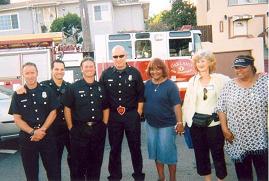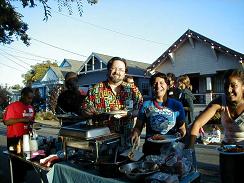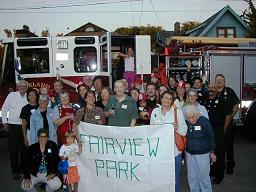Oakland Neighborhood Watch Wins 2007 Award of Excellence
 The revitalization of Oakland 's Neighborhood Watch program is no Cinderella story. Membership numbers didn't soar with the flick of a wand or a sprinkling of fairy dust. Instead, transformation came to Oakland over the course of three long years, thanks to the hard work and dedication of the city's civilian community organizing staff, sworn police officers, and residents whose efforts led to an increase in the number of Neighborhood Watch groups from 50 to 487—and the tally is growing. This past June, the Oakland Police Department received the National Sheriffs' Association/U.S. Department of Justice's 2007 Award of Excellence in recognition of its outstanding achievement.
The revitalization of Oakland 's Neighborhood Watch program is no Cinderella story. Membership numbers didn't soar with the flick of a wand or a sprinkling of fairy dust. Instead, transformation came to Oakland over the course of three long years, thanks to the hard work and dedication of the city's civilian community organizing staff, sworn police officers, and residents whose efforts led to an increase in the number of Neighborhood Watch groups from 50 to 487—and the tally is growing. This past June, the Oakland Police Department received the National Sheriffs' Association/U.S. Department of Justice's 2007 Award of Excellence in recognition of its outstanding achievement.
Despite program success and national recognition, Oakland Neighborhood Watch leaders are not content to end the story with a “happily ever after.” The drive to increase participation in the city's Neighborhood Watch program continues, and it is a key component of a larger, ongoing effort to improve Oakland 's community policing program. This article illustrates the fundamental role Neighborhood Watch has played in the successful effort to realign and revamp Oakland 's crime prevention and community policing services and discusses the city's goals for the future.
Oakland and Neighborhood Watch: A History
Located on the San Francisco Bay , Oakland , California , is a diverse community of approximately 415,000 residents and the eighth-largest city in the state. Oakland law enforcement leaders contend with a dearth of big-city problems, ranging from poverty and social issues to petty crime, homicide, and drug-related violence. In 1996, the Oakland Police Department established its community policing program in an attempt to address these chronic problems through use of a collaborative problem-solving approach. The resolution called for the establishment of 57 Neighborhood Crime Prevention Councils, one in each police beat, to be organized by staff Neighborhood Services Coordinators.
At that time, the various crime prevention organizations and special programs, including Neighborhood Watch and National Night Out, were only loosely connected to one another. In 2005, the Oakland City Council passed an amendment to reorganize its community policing program by consolidating program elements using a tiered approach that encourages community members to become involved at three levels: on their block with the Neighborhood Watch program, in their neighborhood or beat with the Neighborhood Crime Prevention Councils program, and citywide with a bi-annual Community Leadership Summit and organizations such as the Community Policing Advisory Board. Charged with implementing the reorganization, Oakland 's Neighborhood Services Division has set the bar high, adopting a goal to establish 3,000 Neighborhood Watch groups in Oakland by 2017. With 10 years remaining in which to achieve this goal, the division is off to an impressive start. One important key to this early success is simple: community capacity building, the process by which division staff work with community members to build their skills so that these community members can work more effectively with each other and with the police to prevent and solve problems.
Bowling and Daffodils
What do a game of tenpins and flower-gardening have to do with community involvement and crime prevention? Plenty, if you ascribe to the principle of social capital. According to Robert Putnam, Harvard University professor and author of Bowling Alone: America's Declining Social Capital , Americans are no longer the “joiners” we once were. Membership in civic and social organizations such as the PTA has declined and, as a result, Americans have become increasingly disconnected from each other and their communities. Putnam cites the sport of bowling, stating that although the number of individual players has grown in recent years, league membership has plummeted. The result of this decline in civic affiliation is a loss of social capital, a term used to define the substance that builds trust and bonds members of a community together and helps them mobilize resources, share information, and solve problems. Through community capacity building, citizens raise vital social capital.
The 2005 amendment to Oakland 's community policing resolution was based on the principle of social capital. Neighborhood Watch has become an important component of the city's community policing program because it closely adheres to the principle of social capital with a focus on uniting individuals and building groups at the block level. “Training people in crime prevention is only part of the story. Neighborhood Watch connects people with each other,” explained Claudia Albano, neighborhood services manager of the Oakland Police Department. “The process begins with neighbors simply gathering together and getting to know each other. From there they can do anything, from disaster preparedness and crime prevention to planting daffodils to beautify their neighborhood.”
 Indeed, this November, several Oakland Neighborhood Watch groups plan to take part in the city's fourth annual Plant Daffodils! event sponsored by Keep Oakland Beautiful. Participants will receive free bulbs to plant in public locations, and they will become stewards responsible for their area's upkeep as part of the city's Adopt-a-Spot program.
Indeed, this November, several Oakland Neighborhood Watch groups plan to take part in the city's fourth annual Plant Daffodils! event sponsored by Keep Oakland Beautiful. Participants will receive free bulbs to plant in public locations, and they will become stewards responsible for their area's upkeep as part of the city's Adopt-a-Spot program.
Help Wanted: Creative Recruitment
The number of Neighborhood Watch groups in Oakland has risen more than 900 percent in the past three years thanks to innovative marketing and recruitment efforts made in conjunction with collaborative projects such as that described above and events such as the National Night Out block party campaign. Oakland 's National Night Out now boasts more participants in this annual crime prevention event than any other city in America . Last August, approximately 17,000 children and adults enjoyed barbeque, music, and conversation at 315 block parties held citywide. Josephine Lee, a block captain from north Oakland , welcomed some 40 participants at a get-together held for San Pablo Avenue area residents. Besides food and fellowship, the event welcomed police officers who taught local children about safety and crime prevention and presented them badges after a “swearing in” ceremony. The deputy fire chief also was on hand to answer residents' questions and listen to neighborhood concerns. “Mainly we just talked and got to know one another,” said Lee. However, she added that public events such as National Night Out help bolster support for Neighborhood Watch and provide volunteers the opportunity to update neighborhood maps and rosters. Neighborhood Watch leaders also network at these events to learn if neighbors have special needs, such as oxygen, in order to better prepare for emergencies.
Technology also plays an important role in Oakland Neighborhood Watch recruitment. “Sometimes you don't get one-hundred-percent turnout at block parties or other events,” Lee explained, “but we try to keep all our neighbors posted about what's happening.” The group uses email to notify block residents of upcoming events as well as to alert them to recent scams and area crimes. Group members have set up a dedicated Internet-based forum on Yahoo! to share ideas and solve problems.
Lee's Neighborhood Watch group employs more traditional recruitment techniques as well. “We've been very successful with door-to-door canvassing,” she said. Additionally, group block captains regularly attend the neighborhood- and beat-level Neighborhood Crime Prevention Council meetings and interface with the Neighborhood Service Coordinators in order to share important crime prevention information and training and to recruit new members. The Neighborhood Services Division also generates Neighborhood Watch participation by using the services of a long-time Neighborhood Watch volunteer who sends letters to burglary victims that provide information on how to join a group.
Synchronize Your Watches!
Without the integrated block-neighborhood-citywide approach to community policing, the Oakland Neighborhood Watch program would likely have withered on the vine. Likewise, without the Neighborhood Watch program operating at the block-level, development of the city's community policing program would have been impossible. The 2005 amendment underscored the importance of integrated communication at and among the three levels in its vision statement for the Neighborhood Services Program: “Every block is organized, and every neighbor is skilled, networked, and empowered to work together and in partnership with the city to solve problems and build a healthy, resilient community. ”
According to Albano , Neighborhood Watch is an integral component of this effort and an excellent conduit for building social capital. “Neighborhood Watch and the Neighborhood Crime Prevention Councils are good entry points for getting people involved in civic life,” she explained. Often, Neighborhood Watch serves as a bridge for members to cross from the block level to involvement in neighborhood- and city-level issues and events. Leadership and crime prevention skills learned on one small city block can then be leveraged throughout the neighborhood and citywide. Albano noted that Neighborhood Watch is especially important because, when Neighborhood Watch groups participate in the Neighborhood Crime Prevention Councils, they represent block-level concerns and an organized constituency.
“Training in leadership and problem-solving is just as important as crime prevention training. Block leaders need to know how to organize their neighborhoods,” said Albano, discussing Oakland 's efforts to hone leadership skills on the grassroots level. “We build our volunteers' skills in organizing and teach them how to work to solve problems. This filters through to the neighborhood and citywide levels, where we have events such as our Community Leadership Summit.” The Oakland Police Department's community policing staff (Neighborhood Service Coordinators) are trained in the principles of community organizing, meeting facilitation, and program-solving so that they, in turn, can more effectively train and mentor block captains and other group leaders.
The Challenges of Change
Although the restructuring of the Oakland Neighborhood Service Program has proven challenging, it has also provided an opportunity for further assessment of the city's crime prevention and community policing programs. Albano and the Neighborhood Services Division continue to investigate ways to strengthen the link between Neighborhood Watch and the Neighborhood Crime Prevention Councils. The division is also in the process of reassessing current Neighborhood Service Coordinator beats and developing criteria for beat assignment. “Beats need to be assigned based on specific rationale,” explained Albano . “We have come up with 11 indicators, such as crimes types and percentages, number of children in the beat participating in the free lunch program, and so forth. Each beat is ranked from least to most stressed. We want each Neighborhood Service Coordinator to have only one top stressor beat and bilingual staff to be assigned to beats where they can use their language skills.”
Besides being a culturally diverse community, Oakland is home to citizens of widely varying economic means. An ongoing challenge has been to unite members of Oakland 's crime prevention organizations, who often share very different concerns. The hillside community of Montclair , for example, is home to an affluent population of homeowners who often are separated by distance and topography. Crime in this area has been limited mainly to vehicle and property theft, and residents typically are more concerned with disaster preparedness and community beautification than crime prevention. In contrast is the San Pablo Avenue community, where assault and burglary are more prevalent. Dedicated volunteers such as Neighborhood Watch block captain and Oakland safety activist Nick Vigilante are making inroads to improve communication among the city's distinct Neighborhood Watch groups and Neighborhood Crime Prevention Councils.” In Vigilante's Watch group, volunteers have pieced together community members one by one and block by block. “Five years ago, the east side of Montclair didn't talk to the west side,” he stated. “Today, residents know each other, and they recently worked together to design and landscape a park at the north entrance to the neighborhood.”
 Working door-to-door and block-by-block is time-consuming, but in Oakland , early results of the city's ongoing effort to revitalize its community policing program are impressive and very encouraging. Individual citizens, through participation in Neighborhood Watch and the Neighborhood Crime Prevention Councils, are learning the skills needed to work with each other and in collaboration with law enforcement to build the foundation for a stronger, safer, and more pleasant community that all Oaklanders can be proud to call home.
Working door-to-door and block-by-block is time-consuming, but in Oakland , early results of the city's ongoing effort to revitalize its community policing program are impressive and very encouraging. Individual citizens, through participation in Neighborhood Watch and the Neighborhood Crime Prevention Councils, are learning the skills needed to work with each other and in collaboration with law enforcement to build the foundation for a stronger, safer, and more pleasant community that all Oaklanders can be proud to call home.



